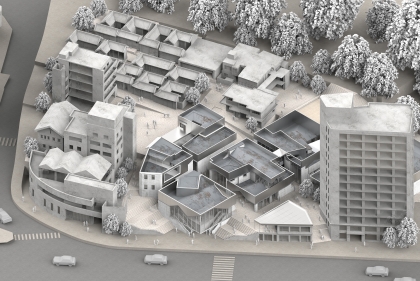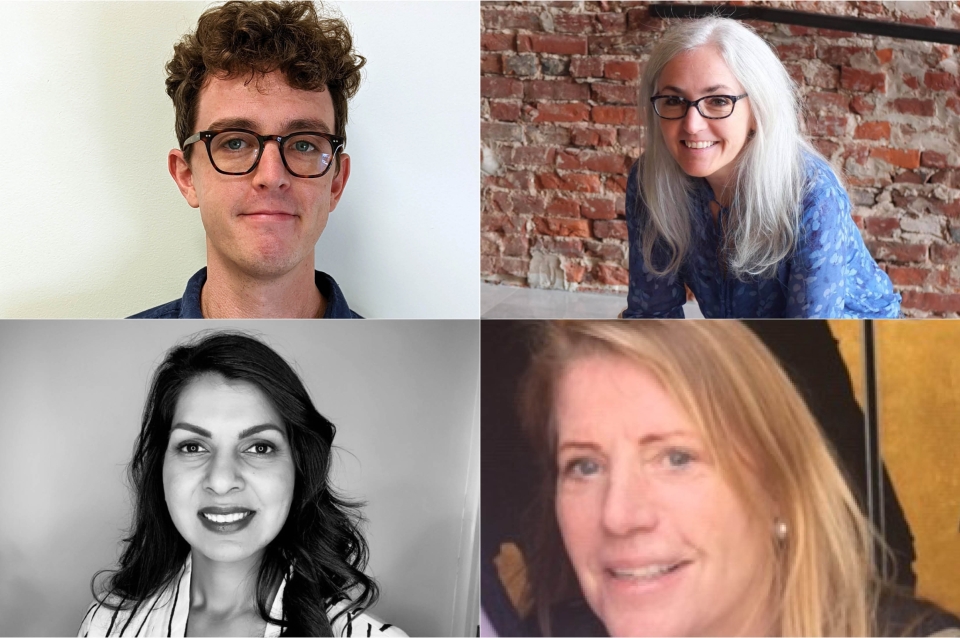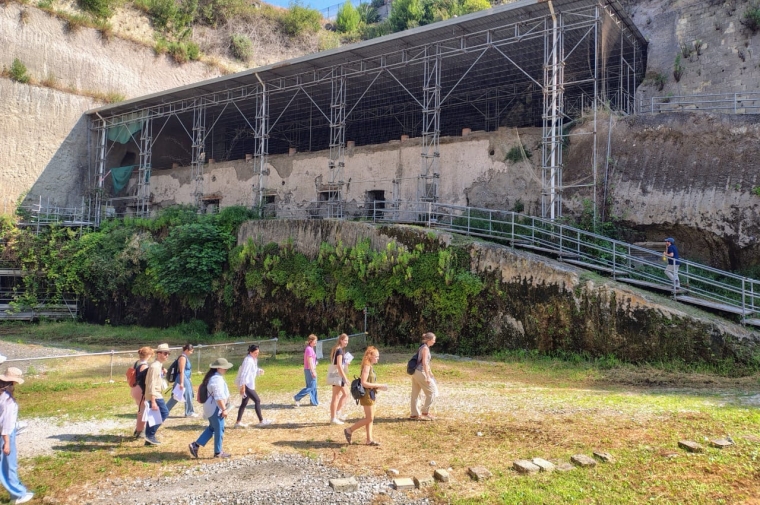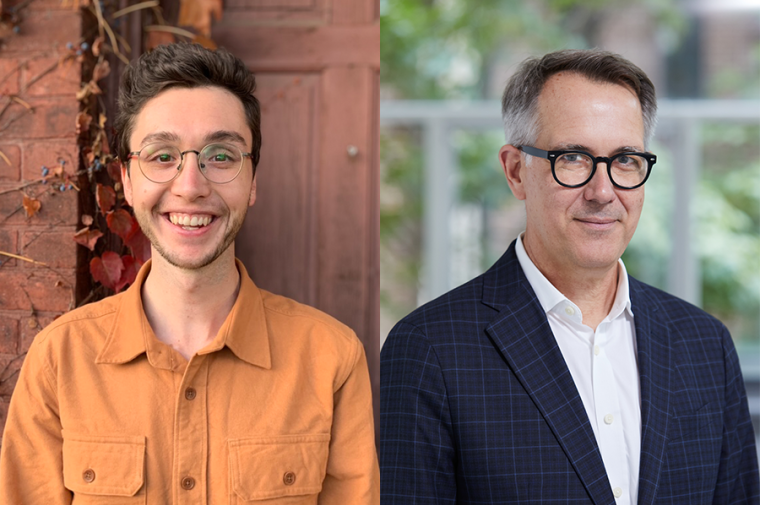April 6, 2023
Stuart Weitzman School of Design
102 Meyerson Hall
210 South 34th Street
Philadelphia, PA 19104
Get the latest Weitzman news in your Inbox
Areas
The one-year Master of Science in Design with a concentration in Historic Preservation directly addresses the needs of practicing design professionals seeking post-professional training or specialization in the historic built environment. Since its launch in 2018, the program has graduated seven preservation architects. In this roundtable conversation, Frank Matero asks four of the program's alums about their motivation behind pursuing the degree, and how returning to the classroom has shaped their careers since.
Frank Matero: Welcome everyone and thank you for joining me today to discuss our relatively new Master of Science in Design in Historic Preservation. Collectively you represent each year since the program was started in 2018. So let me begin with the question: What was your motivation for pursuing the Master of Science in Design with a concentration in Historic Preservation?
Jyotsna Naga (MSD-HP '19): Basically, it was my love for old buildings. Growing up in India, I saw a lot of buildings around me neglected and succumb to various levels of vandalism and disrepair. In my youth, I often wondered - “what would it take to rescue these buildings?” The thought of researching their history, backtracking their journey, and deciphering their architectural style, fascinated me. After pursuing a bachelor's in architecture, I learned some necessary skills, but I knew I needed further specialization.
Holly Boyer (MSD-HP '19): I had been practicing architecture for about 30 years. The first half of my career had been in historic preservation, and the second half of my career had been in new construction. So, when I saw the MSD-HP program advertised, it struck me as a great opportunity for two things. One, it enabled me to reenter the world of preservation after having been out of it for a long time, just in terms of brushing up on what current preservation philosophy is, and putting me in direct contact with people in the profession in Philadelphia. Second, it's a tremendous value to be able to get a master's degree in a year. I had always wanted to do that, but I couldn't really conceptualize how I could take off two years from work. One year seemed like a palatable leave of absence.
Drew McMillian (MSD-HP '22): In a similar situation to most, I had been practicing for about five years. I got licensed and was on a trajectory, the way the places you work start to shape your options for the future. I had dabbled in existing buildings and preservation adjacent work, but was definitely not working in preservation or at a preservation focused firm. And I realized I really liked that work, and realized I wanted to be more engaged with it. I figured I could go find another job, and sort of learn by working. But I found the MSD as an opportunity for a formal diversion, to really redirect a career. The most important thing for me was it gave me a way to think of myself and present myself as a preservation professional, not just an architect who does some preservation-y stuff. It legitimized my interest in a way that was really important.
Michele Kolb (MSD-HP '21): I think my motivation was really multifold. After practicing for a long time and having a very successful career in architecture, with a partner in New York City doing a lot of renovation work in New York, a lot of townhouses, historic work, landmarks approvals, I reached a point in my career where I had wanted to go on for a Master's and I wasn't sure what it would be in architecture. The MSD-HP is a great program. The timeframe was perfect for a working professional, it did allow me to continue working as I was going through it, although it was incredibly intense. I realized through it, I was doing a lot of the restoration preservation work intuitively, and I really felt like I needed more of a prescriptive method in terms of protocol. And for that, the program was terrific. I realized how much I really didn't know, at this late stage in my career. You can never stop learning.
I think the major benefit for me was what I learned in the Building Pathology course because you know, you're always looking at something and trying to diagnose an issue or problem but really having a set of standards and steps to follow in analyzing pathology was extremely helpful. Now, I just relish knowing what I'm looking at on a site. It’s an outstanding program for any professional who wants to add on to their career and just learn more. I did the program in 2020 and was able to do it all online here in Nantucket due to the pandemic, so I was able to use Nantucket as my backdrop for most of my research and study which could not have been better. It was like living in a historic snow globe.
FM: My next question is, what opportunities did the year long program offer? Which is another way of asking, what did you find most useful, or what really took you by surprise in terms of the curriculum or even just the experiences that you had?
JN: The year-long program equipped me with a variety of useful tools. Hands-on laboratory exercises in the Conservation Science class taught me how to scientifically analyze and test materials. The Pathology class explained how to identify ailments in a building. Through the Public Policy class, I was able to explore the policies outlined at the local, state, and federal levels. The Preservation Theory class gave me a thorough basis for understanding major concepts behind preservation. These classes in particular where foundational to the advancement of my understanding of preservation.
Some of the most enjoyable and educational exercises I took part in during the program where working on live sites - for example, working at Wharton Esherick Museum through the Wood Conservation Seminar; the summer studio at the George Nakashima Woodworker; Penn Museum pathology study through the Building Pathology class.
My participation in the year long program also opened doors to other valuable experiences outside of Penn. These experiences included volunteering at Habitat Restore – Philadelphia, volunteering as a Conservation Architect in Aphrodisias, Turkey and participating in a month-long certification program on the Conservation of Earthen Architecture conducted by Getty Conservation in collaboration with the Ministry of Culture and Tourism Abu Dhabi.
In Aphrodisias, I had the honor and pleasure of working on a 3rd-century Greco-Roman site, with experts from various fields for two months. The Earthen Architecture program was a excellent compilation of hands on workshops, conservation theory classes, earthen conservation methods, and intervention strategies taught by eminent practicing professionals in the field. Both experiences where truly life-altering and enriching.
Finally, my time at Penn allowed me to return to campus and audit the American Architecture class. This class equipped me with additional knowledge to help me in my current role as a project manager at SCF Architecture. All in all, the education I received in the year long program did not stop after graduation. Rather, my time at Penn opened many doors and opportunities that have helped me build my career ever since.
HB: The MSD program opened two massive doors for me. The first was my thesis, which was optional, and I was pretty sure I had lost my mind when I realized how much work it was going to be. But it served as the basis for my first (and only) published article, which ended up winning the David Fischetti prize from APT-International. So, it was so worth doing that, and it's put me in touch with so many preservation professionals that have reached out to me. I’ll be doing a webinar on the topic for APT-I sometime this spring. And I learned recently that my article is required reading in a college course taught by Rick Ortega. I'm so flattered. And it all sprang from the program. When you’re working full-time, you just don't have the time or resources to do research that deeply. So, the program gave me the opportunity to really dig into a topic that I cared about. The second door that it opened for me, was in employment. I worked at a couple of private preservation architecture practices over the last few years. But it eventually led me to my new role as the Historical Architect at Independence National Historical Park with the National Park Service. I've only been here a month but I just absolutely love it. Five years ago, I was building schools in South Jersey, and now… it's quite a leap. And it's because I took the step to go back to school.
FM: I think you're the only one so far who's done a thesis in lieu of an advanced studio. But that speaks to the flexibility of the program. Clearly, each of you could make a customized program. There's enough flexibility to allow you to move where you want to move with respect to your career goals and your interests.
DM: Holly brought it up briefly, but it was incredibly valuable to just pause, and not just be focused constantly on the task at hand and whatever project you happen to be working on, to be able to step back and take a holistic view of the current conversations. I also found the diversity of backgrounds among the faculty outside of architecture really important. They were historians, conservators, engineers, they were from other disciplines, reflecting back on the things I already knew about with a new lens. That was so valuable to me, just to have another perspective, because you don't get that in a typical architectural education. The other big opportunity was just the network of people. The preservation world is not that big, and I've been amazed at how many people I feel like I know--even if I don't know them on a personal level. I know where conversations are happening, or who to go look for. And, you know, I work for a Penn grad now, and the program was definitely how that introduction got made.
FM: Michele, you had mentioned Pathology. But anything else you want to add about what doors opened, what opportunities? You had been practicing of course for a long time.
MK: I think recently that opportunity to be part of the NPS/ICCROM Climate Crisis and Heritage symposium up here on Nantucket, regarding climate crisis, and actually quantifying historic materials and being able to develop testing standards for them, really speaks to the issue of why preservation is so valuable to us all. There is just a finite number of materials available, and they do need to be reused and reclaimed and without standards, it's not universally possible. The symposium participants were from all over the world all talking about the same need for this and eye opening in terms of how critical preservation and sustainability are and must work really hand in hand. It was a unique opportunity. Certainly, through this program in my everyday work on Nantucket, with the abundant historic materials I developed an imperative, fostering a mindset of reclaiming and reusing. I wanted to add that Pam Hawkes’s course on considering contemporary design with historic structures was mind opening and developed a whole new consciousness of how to deal with those two factors.
I would just like to add one other last note, I personally found the program incredibly empowering, in terms of my work and what I do and for the world at large and I think that's a good mindset to go forward with. It’s an outstanding program.


 Expand Image
Expand Image


